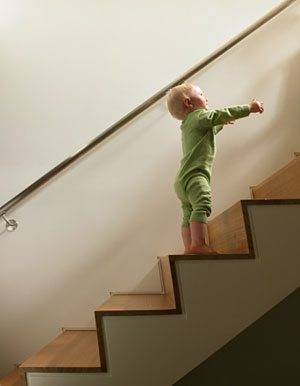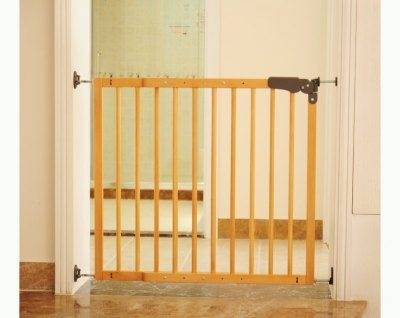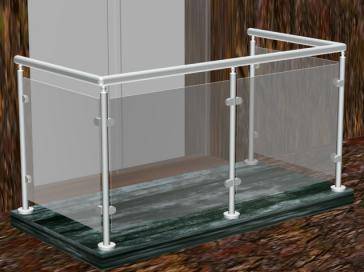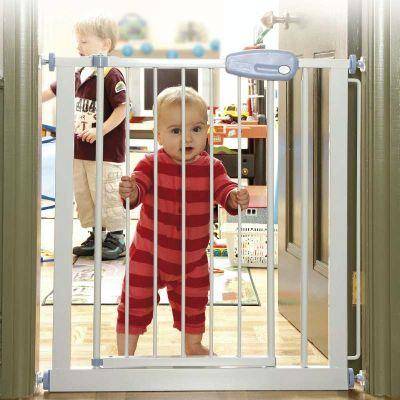Any staircase is an object of increased danger even for healthy adults, not to mention children and people with disabilities. Therefore, in institutions for schoolchildren and preschoolers, as well as in many private houses, special fences are made for children on the stairs.
They can have different purposes: generally block access to steps, ensure the safety of the child when descending and ascending, or limit the ability to climb over the railing. One or another ladder fence for children is used depending on their age and regulatory safety requirements.

Safety barriers and gates
The easiest way is to save very young children who are just starting to crawl and walk from trouble. To do this, you just need to exclude access to the steps by special barriers and gates installed at the beginning and end of the stairs.
Types of barriers
The industry produces two types of barriers, differing in design, size and method of attachment:
- Security gate - these are structures limited in width, installed in a spacer between walls or stair balusters. There are spacer bolts along the edges of the products at the top and bottom, with which they are held in place without the need to drill walls or other stops.

- Sectional railings for stairs from children are like a fence with a wicket, consisting of several connecting sections. In order for such a fence to be stable, it is not installed in a straight line, but along a broken line, in a semicircle, or closed in a ring, getting a kind of playpen that limits the movement of the child. As a rule, the outer sections are attached to rigid supports.

Important!
When buying or making such barriers with your own hands, special attention should be paid to the locking devices of the gates.
They should be equipped with double or triple action mechanisms so that children cannot open them on their own.
Materials for making
Any products that a child comes into contact with in one way or another should not only ensure his physical safety, but also be harmless to health, and, preferably, contribute to his development. Therefore, a child safety fence is made of materials such as wood, aluminum, plastic or stainless steel, as well as combinations thereof.

Products made from them have the following important properties:
- Durability and high reliability;
- Hypoallergenic;
- Interesting and versatile design, the ability to choose a design that matches the style of the interior;
- Possibility of any decorative treatment, giving the barrier a bright color;
- The possibility of self-assembly and installation - for this, detailed instructions are attached to such products.
Criterias of choice
When choosing stair barriers, there are many details to consider besides their design. After all, this is not so much a piece of furniture as a means to protect young children from possible injuries.
Therefore, make sure that the product you choose meets the following requirements:
- The design should be devoid of sharp corners and protruding elements that can injure the baby;
- Solid rungs at or slightly above the floor, remaining in place when the wicket is opened, are not allowed. This is a very traumatic element that you can stumble over when entering or leaving the barrier with a child in your arms;

- All sections of the fence to the stairs from children must be securely connected to each other and consist only of vertical parts so that the baby cannot climb over it or climb up;
- The distance between the vertical parts of the fence should be such that it is impossible to crawl through the bars or get stuck between them. This distance is 10-12 cm, no more;
- It is desirable that the wicket open in both directions - this is convenient and safer;
- The wicket door should lock automatically. Alternatively, the locking device must be operated with one hand;
- It is very important to check the availability of quality certificates that guarantee the safety of the product and the materials from which it is made.
Railings and handrails
The children's stair rails described above are relevant up to two to three years of age. Older children are already able to open latches and locks or climb over a fence. And it is impossible to completely restrict their movements until they reach a conscious age. Therefore, over time, other measures have to be taken to make the ladder safer.
These include anti-slip step covers and comfortable handrails.

Rules and regulations for childcare
In children's institutions, the requirements of SNiP 2.08.02-89 "Public buildings" are mandatory.
This regulatory document regulates the height and design of stair railings, materials for their manufacture, and installation requirements.
For reference. Railings are usually called barriers along flights of stairs and landings, as well as around the gap on the upper floor.
And the handrail is the part of the handrail that provides additional safety when driving.
A ladder guard for children is mandatory if they consist of more than three steps.
Child safety issues when using stairs are also considered in departmental building codes. Here are the basic requirements and guidelines contained in these documents:
- The fence of stairs for children should be at least 120 cm in height, and in some cases it can reach 180 cm. First of all, this applies to institutions for the treatment and education of children with mental disabilities.

- As with barriers and safety gates, it should only consist of vertical elements without crossbars or solid panels made of impact-resistant and safe materials.
- The gaps between the vertical rods of the railing should be no more than 10 cm.
- The recommended diameter of vertical elements is at least 12 mm.
- If glass is used as solid railings, it must be thick (at least 10 mm), with a well-processed edge. Only tempered glass or laminated glass glued to the film (triplex) is allowed.
- Children's stair rails should be equipped with two or three rows of handrails, corresponding in height to different age groups. The upper handrail is at a height of 90-110 cm (for adults and adolescents), the middle one is at a height of 70-75 cm (for children of preschool and primary school age), the lower one is at a height of 50 cm (for kids).
Advice. It is better to attach the handrails for toddlers to the wall rather than to the railing so that the child cannot climb onto them and fall.

- The recommended diameter of the handrails is at least 2.5 cm.
- When cornering between marches, the handrails must not be interrupted - they must be swivel and continuous.
- The materials from which the fence for stairs from children is made must be strong and safe, and the whole structure must be free of obvious protrusions, sharp edges, corners and roughness.
In addition to internal stairs in childcare facilities, the porch is also fenced if it contains more than three steps. A railing with a height of 80 cm is allowed here.
How to keep your child safe at home
If the norms described above are applied to residential premises, outwardly they will differ little from the state ones. In addition, a small child in the house is not a constant phenomenon, he is growing rapidly. And it's easier to keep track of him than a group of 20-30 people.
Therefore, if the staircase in your house is not safe enough, you can temporarily "upgrade" it by covering the wide gaps in the stair railings with a protective mesh or putting protective wooden or plastic covers on the sharp ends of the forged elements.

Also, do not forget about anti-slip pads or coatings for stairs. The cost of such temporary changes is minimal and not comparable to the health and well-being of children.
Conclusion
In the video presented in this article, you will find additional information on this topic. Although it is unlikely that parents or people working with children need to be reminded that it is sometimes impossible to keep track of them, therefore it is necessary to create the safest conditions.






